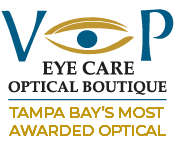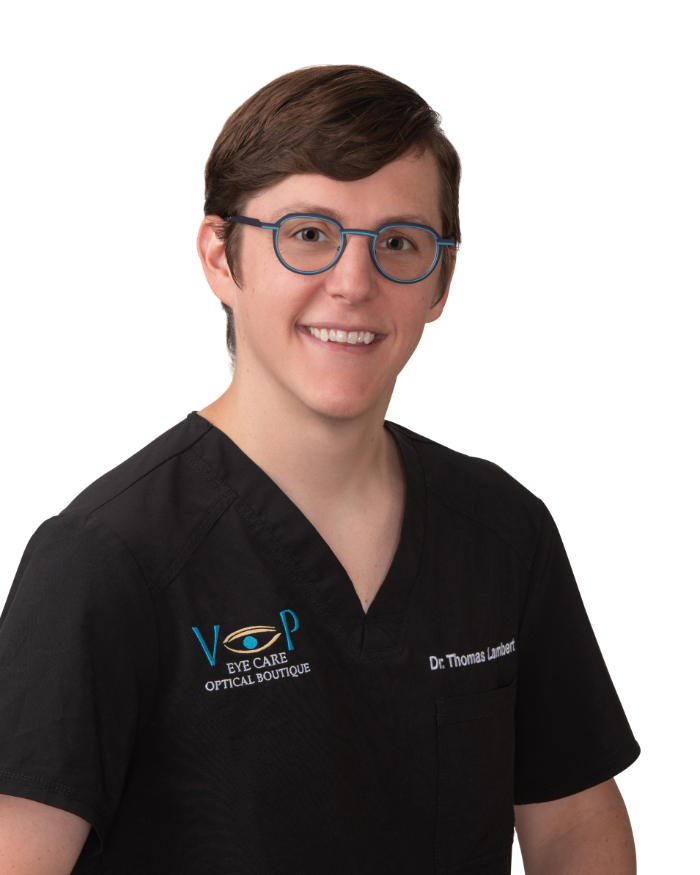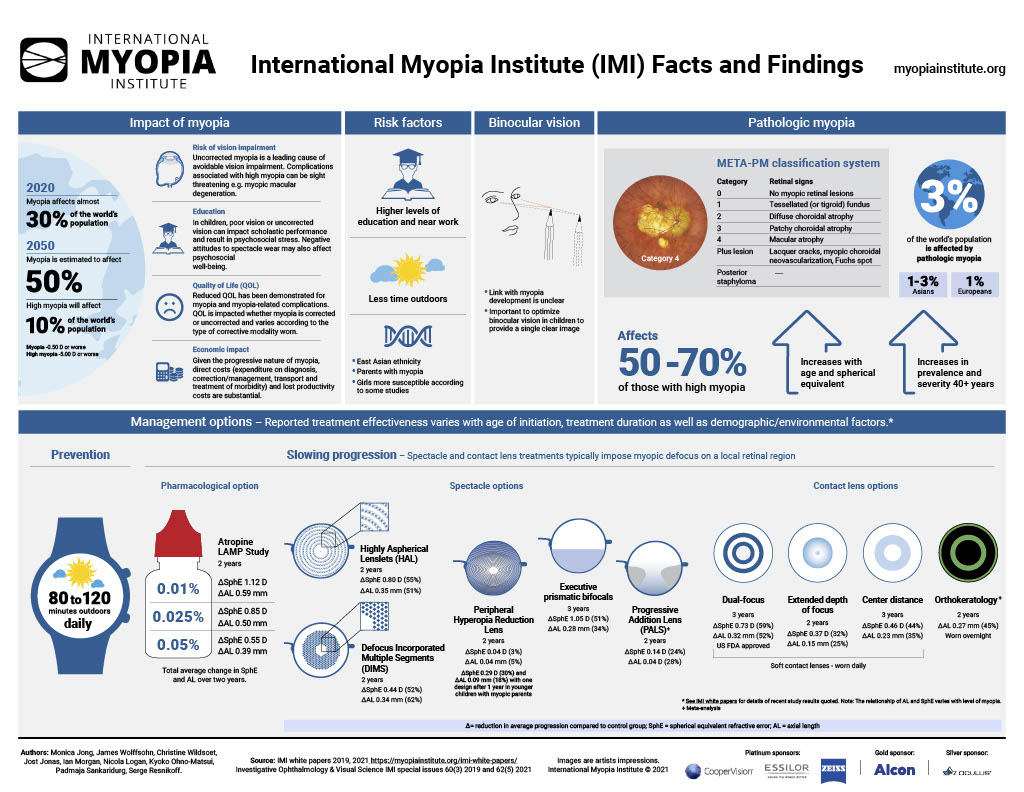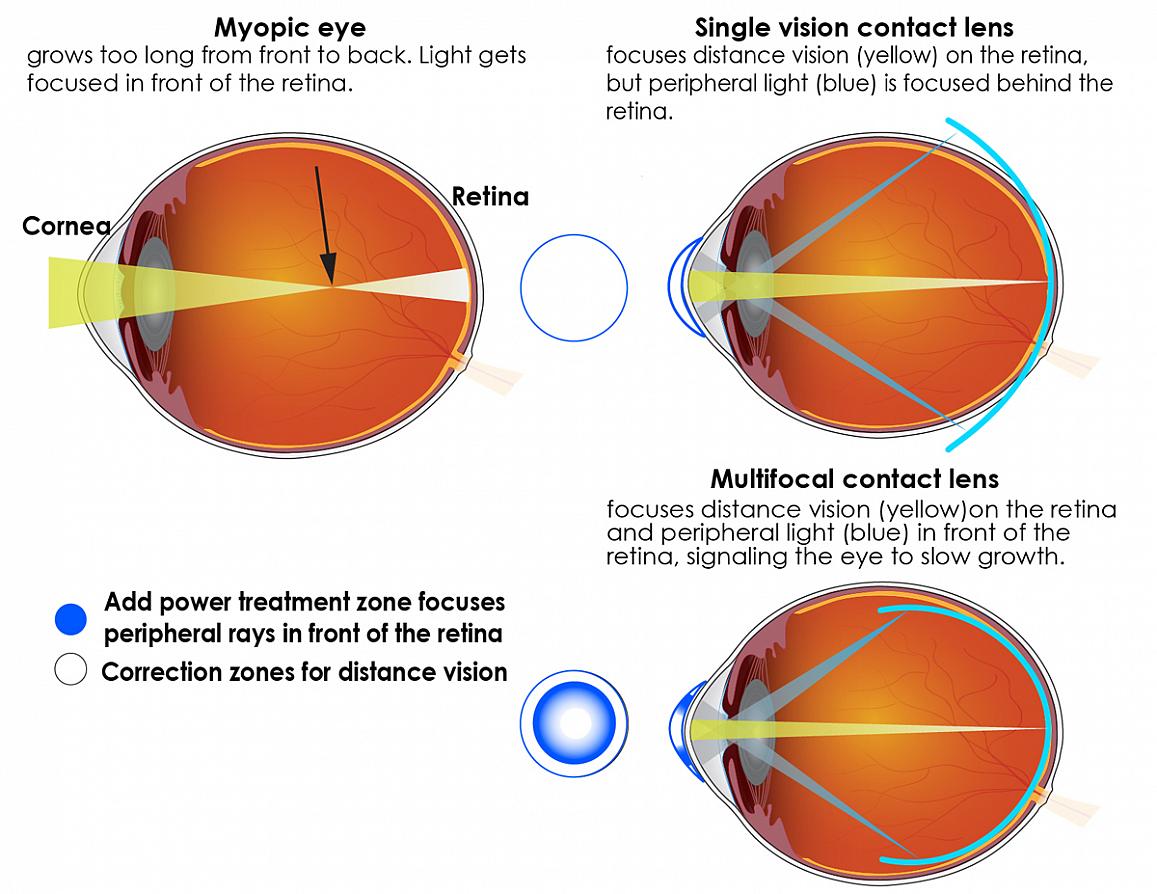Myopia Management
Change Your Child’s Vision;
Change Their Life
Myopia is the medical term for near-sightedness, which is a refractive condition that causes vision to be better at near than at a distance without the help of glasses or contact lenses. It is increasing at an alarming rate, especially among school aged children.
In the early 1970’s only 25% of Americans were myopic, while today over 40% of Americans are myopic.1,2 It is projected that by 2050 around 58% of Americans will be nearsighted.3 Near-sightedness is caused by genetics and lifestyle factors. If one parent is near-sighted, their children are 3x more likely to develop myopia.
That risk increases to 6x if both parents are myopic.4 Examples of lifestyle factors that can contribute to myopia include increase in screen time, reading or school work demands, and more time spent indoors.
Studies have shown that increasing time spent outdoors can lower the risk of myopia.5 Glasses and conventional contact lenses are options to help children see clearer, but there is a 96% chance that the prescription will worsen during adolescence.1
While it is difficult to completely eliminate screen time from children, new methods to help slow the progression of near-sightedness have been developed. Most methods focus on slowing the growth of length of the eye, which is the main cause of myopia.
Different contact lenses are used to defocus light on the edges of the retina. This keeps the retina from extending further and prevents the eye from becoming longer and more myopic. Higher amounts of near-sightedness increase the risk of developing various eye diseases later in life, such as glaucoma, cataracts, retinal detachments, and myopic maculopathy.6
At VIP Eye Care, we focus on specialty contact lenses to help manage this disease.
There are two types of contact lenses that can be used – one soft and one hard. Children can be fit in these contact lenses at ages 8-12, but can be fit at an even younger age if it is a special case. The soft contact lens is a daily-disposable lens that is worn for 10-11 hours per day and for at least 6 days per week. In contrast, the hard contact is worn at night and helps reshape the front surface of the eye.
During the day, the child will not have to wear glasses or contacts. This is a nice option for patients who are active in swimming or sports so they can be free of correction throughout the day. It is common practice to never sleep in contact lenses, but these are specialty contact lenses designed to be slept in at night. It is not recommended to sleep in any soft lenses for myopia control.
If your child has developed near-sightedness, or if you are concerned your child is developing near-sightedness, you can schedule an appointment at our office in Carillon for a consultation.
We can determine if your child is a good candidate for myopia control and if so, what specialty contact lens would be the best option for them.
1 Cooper, Y. (2019, May 1). With Childhood Myopia Rates on the Rise, the American Optometric Association Highlights the Importance of Early Intervention through Annual Eye Exams. Retrieved from https://www.aoa.org/newsroom/myopia-rates-on-the-rise-syvm
2 What You Should Know if Your Child is Nearsighted (Infographic). Retrieved October 29, 2019 from http//www.allaboutvision.com/parents/myopia-facts-infographic.htm.
3 Holden BA, Fricke TR, Wilson DA, Jong M, Naidoo KS, Sankaridurg P, Wong TY, Naduvilath TJ, Resnikoff S, Global Prevalence of Myopia and High Myopia and Temporal Trends from 2000 through 2050, Ophthalmology, 2016 123 (5):1036-1042.
4 Gifford, P., & Gifford, K. L. (2016). The Future of Myopia Control Contact Lenses. OptomVis Sci. 93(4): 336-343.
5 Xiong S, Sankaridurg P, Naduvilath T, et al. Time spent in outdoor activities in relation to myopia prevention and control: a meta-analysis and systematic review. Acta Ophthalmol. 2017;95(6):551-566. doi:10.1111/aos.13403.
6 Flitcroft DI. The complex interactions of retinal, optical and environmental factors in myopia aetiology. Prog Retin Eye Res. 2012 Nov;31(6):622-60. doi: 10.1016/j.preteyeres.2012.06.004. Epub 2012 Jul 4. PMID: 22772022.
Myopia Management Consultation
To schedule a Myopia Management Consultation, simply complete the Request an Appointment Form. Someone from our staff will then reach out to you directly to secure your appointment. This will allow us to obtain your insurance information so that we may maximize your benefits during your appointment.
We respect all of our patients time. If your arrival is later than 15 minutes to your appointment time, we may have to reschedule.



